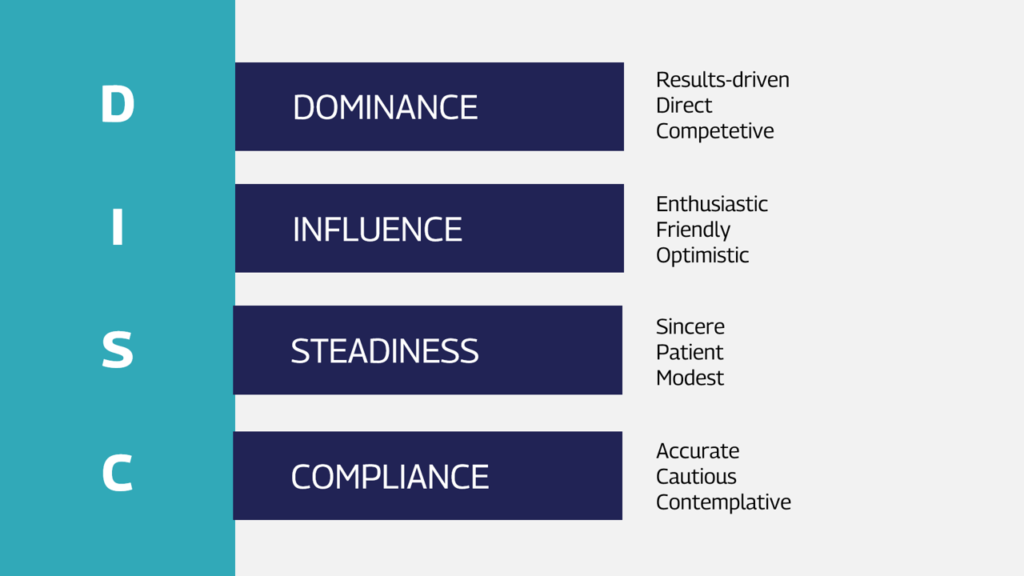Communication based on DISC behavior styles involves understanding the characteristics and preferences that guide other people to adjust your approach to them. All individuals have their unique behavior styles that affect how they think, act, and communicate with others.
The DISC behavior styles formula was developed by American psychologist William Moulton Marston in the 1920s. Marston was interested in studying human behavior and created a theory of four basic behavior styles: Dominant (D), Influential (I), Steady (S), and Conscientious (C). The DISC behavior styles formula was initially used in personality analysis and was later expanded for use in business and interpersonal relationships as a tool to better understand human behavior and communication preferences.
Dominant Style
Individuals with a Dominant (D) style are characterized by a strong will, decisiveness, and self-confidence. They are willing to take risks and make quick decisions. In communication, they prefer a direct approach and focus on goals and results. Good examples of statements for people with a D style are: “We need to act quickly and decisively to achieve our goal,” “We need a clear action plan and strong leadership to succeed.” Incorrect examples of statements for people with a D style are: “You have no idea what you’re talking about,” “You don’t stand a chance of achieving what you want.”
Influential Style
Individuals with an Influential (I) style are energetic and sociable. They are willing to take risks and often make spontaneous decisions. In communication, they prefer emotions and enthusiasm. Good examples of statements for people with an I style are: “This will be an amazing adventure, you have to join us!” “We need to create an atmosphere where people will have fun and work effectively at the same time.” Incorrect examples of statements for people with an I style are: “Don’t worry about the details, just do it!” “We don’t need a plan, let’s just go for it!”
Steady Style
Individuals with a Steady (S) style are attentive and loyal. They are inclined to avoid conflicts and like to work in a group. In communication, they prefer calmness and empathy. Good examples of statements for people with an S style are: “We need to come up with a solution that is good for everyone,” “Are you comfortable with this solution?” Incorrect examples of statements for people with an S style are: “Does it bother you that you have to wait for others?” “We shouldn’t risk changing things, what about people who have been with us for years?”
Conscientious Style
Individuals with a Conscientious (C) style are analytical and precise. They like to have control over the situation and prefer a logical approach to problems. In communication, they prefer specifics and facts. Good examples of statements for people with a C style are: “We need to analyze every detail before making a decision,” “I’d like to see the exact data before making a decision.” Incorrect examples of statements for people with a C style are: “There’s no need to deal with these details,” “There’s no time to analyze every little thing.”
To effectively communicate with others, it is important to understand what behavior style they prefer and adjust your approach accordingly.
In order to effectively communicate with other people, it is important to understand their preferred behavioral style and adjust your approach accordingly. By using the DISC behavioral style framework, individuals can better recognize and respond to the unique communication needs of others, which can help to improve relationships, collaboration, and overall success.
For example, if you are working with someone who has a dominant behavioral style, it may be best to be direct and focus on goals and results when communicating with them. On the other hand, if you are working with someone who has a more stable style, it may be important to take a more empathetic and collaborative approach in order to build trust and foster cooperation.
In addition to helping individuals communicate more effectively with others, the DISC behavioral style framework can also be used to improve teamwork, leadership, and organizational culture. By understanding the different styles and preferences of team members, managers and leaders can create more inclusive and supportive environments that value diversity and encourage collaboration.
Overall, the DISC behavioral style framework provides a valuable tool for individuals and organizations looking to improve communication, build better relationships, and achieve greater success. By recognizing and adapting to the unique communication needs of others, individuals can build stronger and more productive connections with those around them, which can lead to greater satisfaction and fulfillment both personally and professionally.
If you want to take your communication to a much higher level, reach me out and let’s talk about how we can improve communication skills in your team.


